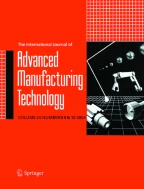Abstract
In this paper, we propose a geometric constraint solver for 3-D assembly applications. First, we give a new geometry and constraint expression based on Euler parameters, which can avoid singular points during the solving process and simplify constraint types. Then we present a directed graph based constructive method to geometric constraint system solving that can handle well-, over- and under-constrained systems efficiently. The basic idea of this method is that it first simplifies the constraint graph by pruning those vertices which have only in-arcs from the graph and then reduces the size of strongly connected components (SCCs) left in the graph by DOF-based analysis. The method can solve all kinds of configurations including closed-loops. After that, we apply a hybrid numerical method of Newton–Raphson and Homotopy to solve under-constrained systems. The hybrid method makes use of the high efficiency of the Newton–Raphson method as well as the outstanding convergence of the Homotopy method. Finally, we give a practical example and conclusion.
Similar content being viewed by others
References
Kim J, Kim K, Choi K, Lee JY (2000) Solving 3D geometric constraints for assembly modeling. Int J Adv Manuf Technol 16:843–849
Light R, Gossard D (1982) Modification of geometric models through variational geometry. Comput Aided Des 14(3):209–214
Sutherland I (1963) Sketchpad, a man-machine graphical communication system. Proc Spring Joint Comp Conference, North Holland, pp 329–345
Gao XS, Zhou SC (1998) Solving geometric constraint systems II. A symbolic approach and decision of rc-constructibility. Comput Aided Des 30(2):115–22
Kondo K (1992) Algebraic method for manipulation of dimensional relationships in geometric models. Comput Aided Des 24(3):141–7
Aldefeld B (1988) Variation of geometries based on a geometric-reasoning method. Comput Aided Des 20(3):117–126
Roller D (1990) A System for Interactive Variation Design. In: Wozny MJ, Turner JU, Preiss K (eds) Geometric Modeling for Product Engineering. Elsevier Science Publishers B.V. (North Holland), pp 207–210
Verroust A, Schonek F, Roller D (1992) Rule-oriented method for parameterized computer-aided design. Comput Aided Des 24(3):531–540
Sunde G (1987) A CAD system with declarative specification of shape. Eurographics workshop on intelligent CAD systems. Noorwijkerhout, The Netherlands, pp 90–104
Kramer G (1992) Solving geometric constraint system: A case study in kinematics. MIT Press, Cambridge, MA
Owen J C (1991) Algebraic solution for geometry from dimensional constraints. Proc ACM Symp Found of Solid Modeling, Austin, TX, pp 397–407
Bouma W, Fudos I, Hoffmann C, Cai J, Paige R (1995) Geometric constraint solver. CAD 27(5):487–501
Hoffmann CM, Vermeer P (1995) Geometric constraint solving in R2 and R3. In: Computing in Euclidean geometry. World Scientific Publishing, , pp 170–195
Lee JY, Kim K (1998) A 2-D geometric constraint solver using DOF-based graph reduction. Comput Aided Des 30(9):883–896
Li YT, Hu SM, Sun JG (2002) A constructive approach to solving 3-D geometric constraint systems using dependence analysis. Comput Aided Des 30:97–108
Peng XB, Chen LP, Zhou FL, Zhou J (2002) Singularity analysis of geometric constraint system. J Comput Sci Technol 17(3):314–323
Hoffmann CM, Lomonosov A, Sitharam M (1998) Geometric constraint decomposition. In: Geometric constraint solving and applications. Springer, Berlin Heidelberg New York, pp 170–195
Ge J-X, Chou S-C, Gao X-S (1999) Geometric constraint satisfaction using optimization methods. Comput Aided Des 31:867–879
Kang YS (1996) Principles and methods of variational assembly design. Dissertation, Huazhong Univ Sci & Tech
Lamure H, Michelucci D (1996) Solving geometric constraints by homotopy. IEEE Trans Visual Comput Graph 2(1):28–34.
Author information
Authors and Affiliations
Corresponding author
Rights and permissions
About this article
Cite this article
Peng, X., Lee, K. & Chen, L. A geometric constraint solver for 3-D assembly modeling. Int J Adv Manuf Technol 28, 561–570 (2006). https://doi.org/10.1007/s00170-004-2391-1
Received:
Accepted:
Published:
Issue Date:
DOI: https://doi.org/10.1007/s00170-004-2391-1
